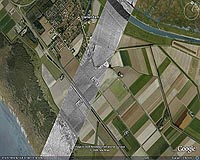 |
Huntsville AL (SPX) Jul 21, 2009 Forty years ago, Apollo astronauts set out on a daring adventure to explore the Moon. They ended up discovering their own planet. How do you discover Earth ... by leaving it? Apollo 8 was the first crewed Saturn V launch and the first time humans were placed in lunar orbit. Mission plans called for the astronauts to photograph possible landing sites for future missions. Before this, only robotic probes had taken images of the Moon's far side. As the astronauts in their spacecraft emerged from behind the Moon, they were surprised and enchanted by an amazing view of Earth rising over the lunar horizon. Bill Anders quickly snapped a picture of the spectacular Earthrise - it was not in the mission script. His timing could not have been better. It was Christmas Eve, 1968, the close of one of the most turbulent, fractured years in U.S. and world history. The picture offered a much needed new perspective on "home." For the first time in history, humankind looked at Earth and saw not a jigsaw puzzle of states and countries on an uninspiring flat map - but rather a whole planet uninterrupted by boundaries, a fragile sphere of dazzling beauty floating alone in a dangerous void. There was a home worthy of careful stewardship. The late nature photographer Galen Rowell described this photo as "the most influential environmental photograph ever taken." "It changed humanity's entire orientation," says Kristen Erickson of NASA headquarters in Washington, DC. "And similar photos taken by the Apollo 11 through 17 crews reinforced the impact of this first view." Apollo photos of the big blue marble energized grass-roots green movements and led directly to the modern fleet of Earth observing satellites NASA uses to monitor and predict weather, examine ozone holes, investigate climate change, and much more.1 Like Anders' camera, these satellites have transformed the way we view the planet we call Earth. We gained all this by shooting for the Moon. The Apollo astronauts were, by their own admissions, profoundly moved and changed when they gazed upon Earth from their unique position in space. "It changed my life,"2 said Rusty Schweickart, Apollo 9 astronaut. "...You only see the boundaries of nature from there...not those that are manmade," said Eugene Cernan of Apollos 10 and 17. "It is one of the deepest, most emotional experiences I have ever had."3 Apollo 17 was the last crewed Moon mission. Since then, no humans have been to the place where they can float and gaze at the whole Earth. The crew of the International Space Station has a beautiful view of Earth, but not the whole Earth. Because the space station is in low-Earth orbit, only a portion of the planet can be seen at any one time. For the big picture view, the Moon can't be beat. Soon, we'll be back. Right now, the Lunar Reconnaissance Orbiter is circling the Moon gathering critical data NASA scientists need to plan for renewed human exploration. NASA is once again charting a daring mission to the Moon - this time to stay. There are many compelling reasons to return. Former space shuttle astronaut Joseph Allen thinks our own planet is one of them: "With all the arguments, pro and con, for going to the Moon, no one suggested that we should do it to look at the Earth. But that may in fact be the most important reason."4 In his recent confirmation hearing to take NASA's helm as administrator, former astronaut Charles F. Bolden said, "I dream of a day when any American can launch into space and see the magnificence and grandeur of our home planet." Until then, a few astronauts will take the ride for all of us, and they'll be carrying cameras a thousand times more advanced than Apollo. What the space agency shows us will surely expand our vision. It always has. Share This Article With Planet Earth
Related Links Science@NASA Earth Observation News - Suppiliers, Technology and Application
 Space Radar Techniques For Land Mapping
Space Radar Techniques For Land MappingParis, France (ESA) Jul 20, 2009 Entrepreneurs at ESA's Business Incubation centre in the Netherlands have used radar technology from the agency's Envisat remote-sensing satellite to develop a compact, high-resolution radar that can monitor land and buildings from small aircraft. The radar can monitor structures such as dams, harbours, canals and buildings, leading to maps for urban planning, territory surveillance and ... read more |
|
| The content herein, unless otherwise known to be public domain, are Copyright 1995-2009 - SpaceDaily. AFP and UPI Wire Stories are copyright Agence France-Presse and United Press International. ESA Portal Reports are copyright European Space Agency. All NASA sourced material is public domain. Additional copyrights may apply in whole or part to other bona fide parties. Advertising does not imply endorsement,agreement or approval of any opinions, statements or information provided by SpaceDaily on any Web page published or hosted by SpaceDaily. Privacy Statement |